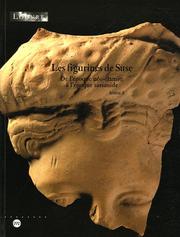| Listing 1 - 10 of 53 | << page >> |
Sort by
|
Book
ISBN: 1789259169 1789259150 Year: 2023 Publisher: Oxford, United Kingdom : Oxbow Books,
Abstract | Keywords | Export | Availability | Bookmark
 Loading...
Loading...Choose an application
- Reference Manager
- EndNote
- RefWorks (Direct export to RefWorks)
"Archaeological remains are 'fragmented by definition': apart from exceptional cases, the study of the human past takes into account mainly traces, ruins, discards, and debris of past civilizations. It is rare that things have been preserved as they were originally made and conceived in the past. However, not all the ancient fragmentary objects were the 'leftovers'from the past. A noticeable portion of them was part and parcel of the ancient materiality already in the form of a fragment or damaged item. In 2000, John Chapman, with his volume Fragmentation in Archaeology, attracted the attention of scholars on the need to reconsider broken artifacts as the result of the deliberate anthropic process of physical fragmentation. The phenomenon of fragmentation can be thus explored with more outcomes for a category of objects that played an important role inside the society: the figurines. Due to their portability and size, figurines are particularly entangled and engaged in social, spatial, temporal, and material relations, and - more than other artifacts - can easily accommodate acts of embodiment and dismemberment. The act of creation symmetrically also involves the act of destruction, which in turn is another act of creation, since from the fragmentation comes a new entity with a different ontology. Breaking contains the paradigms of life: creation and reparation, destruction and regeneration.The scope of this volume is to search for traces of any voluntary and intentional fragmentation of ancient artifacts, creating, improving, and sharpening the methods and principles for a scientific investigation that goes beyond single author impression or sensitivity. The comparative lens adopted in this volume can allow the reader to explore different fields taken from ancient societies of how we can address, assess, detect, and even discuss the action of breaking and mutilation of ancient figurines."-- Provided by publisher.
Book
ISBN: 9781906137526 1906137528 Year: 2018 Publisher: London Golden House Publications
Abstract | Keywords | Export | Availability | Bookmark
 Loading...
Loading...Choose an application
- Reference Manager
- EndNote
- RefWorks (Direct export to RefWorks)
Book
ISBN: 1871266262 9781871266269 Year: 2009 Publisher: London: Darengo,
Abstract | Keywords | Export | Availability | Bookmark
 Loading...
Loading...Choose an application
- Reference Manager
- EndNote
- RefWorks (Direct export to RefWorks)
Figurines, Ancient --- Egypt --- Egypt --- Asyut (Egypt)
Book
ISBN: 9782503548180 2503548180 Year: 2013 Volume: 32 Publisher: Turnhout Brepols
Abstract | Keywords | Export | Availability | Bookmark
 Loading...
Loading...Choose an application
- Reference Manager
- EndNote
- RefWorks (Direct export to RefWorks)
This volume provides a study on the 3rd millennium B.C. anthropomorphic clay figurines of the Middle Euphrates region. The research is based on over 2400 specimens, mostly in a fragmentary state, retrieved in thirteen different salvage excavations located along the Middle course of the Syrian Euphrates, from Tell Shiyukh Tahtani to the north to Tall Bi'a to the south. The volume is subdivided in eight chapters and is aimed to give a deep insight on the anthropomorphic clay figurines of the region under examination. The new synthetic regional typology (based on the large amount of specimens) enables an understanding of figurines development and diffusion in a broader perspective. Particular attention is also paid to manufacturing aspects such as modelling, rendering and decoration. Moreover, the detailed mapping on their distribution provides new hints for the understanding of the use of these objects.
Bronze age --- Terra-cotta figurines, Ancient --- Excavations (Archaeology)
Book
ISBN: 8888233016 Year: 2001 Publisher: Roma Università degli studi di Roma La Sapienza. Missione archeologica italiana in Siria
Abstract | Keywords | Export | Availability | Bookmark
 Loading...
Loading...Choose an application
- Reference Manager
- EndNote
- RefWorks (Direct export to RefWorks)
Terra-cotta figurines, Ancient --- Bronze age --- Ebla (Extinct city)
Book
ISBN: 2859341056 9782859341053 Year: 1983 Publisher: Lyon: L'Hermès,
Abstract | Keywords | Export | Availability | Bookmark
 Loading...
Loading...Choose an application
- Reference Manager
- EndNote
- RefWorks (Direct export to RefWorks)
Bronze figurines, Ancient --- Chalon-sur-Saône (France) --- France

ISBN: 2711843246 2711845400 2711845419 Year: 2002 Publisher: Paris : Editions de la Réunion des musées nationaux,
Abstract | Keywords | Export | Availability | Bookmark
 Loading...
Loading...Choose an application
- Reference Manager
- EndNote
- RefWorks (Direct export to RefWorks)
Terra-cotta figurines, Ancient --- Musée du Louvre. --- Susa (Extinct city)
Book
ISBN: 9786059636605 Year: 2019 Publisher: Ankara : Bilgin Kültür Sanat Yayinlari,
Abstract | Keywords | Export | Availability | Bookmark
 Loading...
Loading...Choose an application
- Reference Manager
- EndNote
- RefWorks (Direct export to RefWorks)
Book
ISBN: 9788862270939 8862270933 Year: 2008 Publisher: Pisa : F. Serra,
Abstract | Keywords | Export | Availability | Bookmark
 Loading...
Loading...Choose an application
- Reference Manager
- EndNote
- RefWorks (Direct export to RefWorks)
Terra-cotta figurines, Ancient --- Bronze age --- Italy --- Antiquities.
Book
ISBN: 9788892850620 Year: 2021 Publisher: Sesto Fiorentino (FI) : All'insegna del giglio,
Abstract | Keywords | Export | Availability | Bookmark
 Loading...
Loading...Choose an application
- Reference Manager
- EndNote
- RefWorks (Direct export to RefWorks)
Small sculpture, Classical. --- Figurines, Ancient. --- Sculpture, Classical --- Reproduction
| Listing 1 - 10 of 53 | << page >> |
Sort by
|

 Search
Search Feedback
Feedback About UniCat
About UniCat  Help
Help News
News